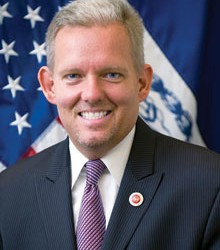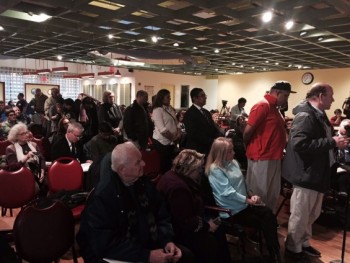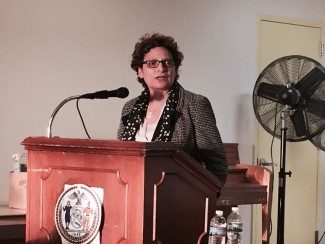
Councilman Van Bramer
The city should have a majority of seats on the MTA board
Opinion: April 27, 2016: By Jimmy Van Bramer
In 1968, the state took over New York City’s buses and subways and created the Metropolitan Transportation Authority. Nearly 50 years later, riders suffer as the MTA struggles with aging trains, bloated projects and long delays for needed upgrades. Meanwhile, the balance of power at the MTA board rests with Albany and the suburbs, preventing the city from governing its own transit system.
Albany’s leadership on the MTA is lacking. It’s time for the city to take control.
As a City Council member from western Queens and a regular subway commuter, I know in real time when the No. 7 train has a meltdown. My phone buzzes with tweets and texts about overcrowded platforms, stalled trains and poor communication from the MTA.
I press MTA officials at oversight hearings, organize rallies, and host town hall meetings that bring MTA leaders directly to riders. But we can and must do more. Unfortunately, because Albany controls the MTA, our city can’t hold it accountable for the quality of service it provides.
Earlier this month, I hosted a town hall where No. 7 train riders asked questions of MTA officials. New York City Transit President Ronnie Hakim had some good answers, but on many issues, she left us scratching our heads. Hakim didn’t seem to know much about cross-honoring MetroCards on the Long Island Rail Road when service is disrupted. One of her colleagues dismissed our claim that service is worse on Mondays after weekend track work, only to have riders cite specific delays and disruptions that the agency forgot.

Town Hall Meeting
A recent report by state Comptroller Thomas DiNapoli showed the MTA used misleading math to calculate how long riders must wait for a train—and found that wait times are actually increasing. The MTA is even failing to meet its own goals.
The signal upgrades and track replacement needed to keep the century-old system from constant malfunction are decades away from completion. There isn’t even a timeline to bring modern signals—which allow countdown clocks and more frequent trains—to half of the subway system.
Even worse, the MTA is mismanaging its biggest, most expensive projects. The new Hudson Yards station is leaking because the MTA’s contractors cut corners. Across town, East Side Access—a bloated project designed to benefit suburban commuters, not New Yorkers stuck on the subway—is $6 billion over budget and 14 years behind schedule.
Albany’s latest budget provides only a portion of the cash required for the MTA to make much-needed upgrades, and in fact raises the MTA’s debt ceiling. By requiring the MTA to borrow billions of dollars instead of funding improvements outright, Albany is setting New Yorkers up for massive fare and toll increases down the line.
As straphangers get squeezed, Albany has little incentive to act. A recent Baruch College/NY1 poll found nearly half of New Yorkers think the city controls the MTA. Who can blame them? The MTA’s own numbers show that 94% of its annual ridership is within the five boroughs.

Ronnie Hakim
And yet, the city is only given four votes on the MTA’s 17-member board. Meanwhile, suburban counties, which include towns as far as Poughkeepsie and Montauk, control the same number of votes.
Adding insult to injury, Albany inaction has held three of the city’s board nominees in limbo since last June.
The city has increased its commitment to funding MTA capital improvements to $2.5 billion. Contrast that with Westchester, Nassau and Suffolk counties, which each have a full vote on the MTA board yet don’t contribute a cent to MTA upgrades from their budgets.
The city deserves a bigger say. I’m calling on the state to increase the city’s representation on the authority’s board, and have sponsored a City Council resolution to this effect. The city, after all, stands to gain the most from improved service—or suffer the harshest consequences if the system is neglected.
Now is the time. With the city’s future hanging in the balance, it makes no sense for Albany and the suburbs to call the shots for our subways and buses.
Jimmy Van Bramer, D-Queens, is the City Council majority leader.
This opinion piece first ran in Crain’s NY
4 Comments

Everybody should have a teleporter machine, problem solved.
NYC definitely needs more representation on the board of it’s own transit system.
We also need to figure out how to implement a resident/non-resident payment system. I’d be fine having to make a monthly payment for a discounted resident monthly metrocard if the Westchester, NJ, CT and LI people are required pay a little extra to use our transportation system.
I have no problem with LIRR and MetroNorth doing the same and charging me a little extra if I chose to use their services to travel to LI or north of NYC.
I’m sure something like this could easily be implemented along the lines of the senior citizen discounted metrocard system.
Nice in theory. But the people outside of the city don’t choose to use “our” transportation system. They have to use it to get to work. A lot of people commute from outside of the city and need to use the system daily. You taking a day trip out of the city and being willing to pay a little extra if you choose to use the system is not the same as needing to use the transportation system.
While mosst of what Jimmy No Brainer said is right. He continues to overdevelop his own area (LIC Queens) and strain the # 7 and other lines that run through LIC . Too many people and the subways and roads caant hanle them. The state should do more but the can the city do aany better at running things? We could use more votes on the panel and members.